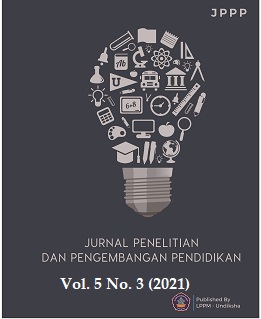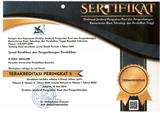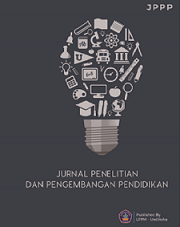Peningkatan Kepuasan Mahasiswa dalam Pembelajaran E-Learning melalui Task Technologi Fit dan Kualitas Informasi
DOI:
https://doi.org/10.23887/jppp.v5i3.39977Keywords:
Task Technology Fit, kualitas inforamsi, kepuasan mahasiswaAbstract
Pandemi Covid 19 di awal tahun 2020 menyebabkan perubahan metode pembelajaran tatap muka menjadi metode pembelajaran berbasis online. E-learning merupakan salah satu metode pembelajaran berbasis olline yang akhirnya menjadi kebutuhan dan tumpuan saat pandemi. Penggunaan teknologi yang tepat akan mendukung proses pembelajaran. Untuk itu, teknologi harus dapat dimanfaatkan dan sesuai dengan kebutuhan, sehingga mampu mendukung tugas. Kualitas informasi yang up-to-date, akurat, relevan, dan tepat diperlukan guna mendukung proses pembelajaran, sehingga keduanya dapat memberi dampak positif bagi pengguna. Tujuan penelitian ini untuk mengetahui pengaruh Task Technology Fit (TTF) dan kualitas informasi terhadap kepuasan mahasiswa. Penelian ini merupakan penelitian kuantitatif dengan melibatkan 198 sampel mahasiswa. Metode analisis menggunakan Structural Equation Modeling dengan pendekatan Partial least square (SEM-PLS). Hasil penelitian menunjukkan bahwa TTF berpengaruh signifikan terhadap kepuasan mahasiswa. Kualitas informasi berpengaruh signifikan terhadap kepuasan mahasiswa. Dengan demikian perlu diperhatikan faktor pendorong kepuasan mahasiswa dalam pembelajaran e-learning dari sisi Task Technologi Fit dan kualitas informasi, sehingga tujuan pembelajaran dapat tercapai.
References
Abbas, S. K., Aslam, B., Hashmi, Z. M., Majid, S., Ijaz, T., & Latif, N. (2018). Testing the Impact of Mobile Banking on Individual Performance using Delone & McLean and TTF Models. Global Scientific Journals, 6(7), 867–883.
Abrego Almazán, D., Sánchez Tovar, Y., & Medina Quintero, J. M. (2017). Influence of Information Systems on Organizational Results. Contaduria y Administracion, 62(2), 321–338. https://doi.org/10.1016/j.cya.2017.03.001.
Akkoyunlu, B., & Soylu, M. Y. (2008). A Study of Student’s Perceptions in a Blended Learning Environment Based on Different Learning Styles. Educational Technology and Society, 11(1), 183–193. https://citeseerx.ist.psu.edu/viewdoc/download?doi=10.1.1.571.594&rep=rep1&type=pdf.
Al-Fraihat, D., Joy, M., Masa’deh, R., & Sinclair, J. (2020). Evaluating E-Learning Systems Success: An Empirical Study. Computers in Human Behavior, 102(June 2019), 67–86. https://doi.org/10.1016/j.chb.2019.08.004.
Al-Maatouk, Q., Othman, M. S., Aldraiweesh, A., Alturki, U., Al-Rahmi, W. M., & Aljeraiwi, A. A. (2020). Task-Technology Fit and Technology Acceptance Model Application to Structure and Evaluate the Adoption of Social Media in Academia. IEEE Access, 8, 78427–78440. https://doi.org/10.1109/ACCESS.2020.2990420.
Al-Rahmi, A. M., Shamsuddin, A., & Alismaiel, O. A. (2020). Task-Technology Fit Model: The Factors Affecting Students’ Academic Performance in Higher Education. Universal Journal of Educational Research, 8(12), 6831–6843. https://doi.org/10.13189/ujer.2020.081249.
Al-Rahmi, W. M., Othman, M. S., & Yusuf, L. M. (2015). Exploring the Factors that Affect Student Satisfaction through Using E-learning in Malaysian Higher Education Institutions. Mediterranean Journal of Social Sciences, 6(4S1), 299–310. https://doi.org/10.5901/mjss.2015.v6n4s1p299.
Al-Rahmi, W. M., Yahaya, N., Aldraiweesh, A. A., Alamri, M. M., Aljarboa, N. A., Alturki, U., & Aljeraiwi, A. A. (2019). Integrating Technology Acceptance Model with Innovation Diffusion Theory: An Empirical Investigation on Students’ Intention to Use E-Learning Systems. IEEE Access, 7, 26797–26809. https://doi.org/10.1109/ACCESS.2019.2899368.
Alam, M. M., Ahmad, N., Naveed, Q. N., Patel, A., Abohashrh, M., & Khaleel, M. A. (2021). E-Learning Services to Achieve Sustainable Learning and Academic Performance: An Empirical Study. Sustainability, 13(5), 1–20. https://www.mdpi.com/2071-1050/13/5/2653.
Almaiah, M. A., Al-Khasawneh, A., & Althunibat, A. (2020). Exploring the Critical Challenges and Factors Influencing the E-learning System Usage During COVID-19 Pandemic. Education and Information Technologies, 25(6), 5261–5280. https://doi.org/10.1007/s10639-020-10219-y.
Almarashdeh, I. (2016). Sharing Instructors Experience of Learning Management System: A Technology Perspective of User Satisfaction in Distance Learning Course. Computers in Human Behavior, 63, 249–255. https://doi.org/10.1016/j.chb.2016.05.013.
Alyoussef, I. Y. (2021). E-Learning Acceptance: The Role of Task–Technology Fit as Sustainability in Higher Education. Sustainability, 13(11), 1–15. https://doi.org/10.3390/su13116450.
Amalia, S. R., & Purwaningsih, D. (2020). Pengaruh Self Regulated Learning dan Web Course Berbantuan Google Classroom, Whatsapp Group terhadap Pemahaman Konsep. AKSIOMA: Jurnal Program Studi Pendidikan Matematika, 9(4), 917–925. https://doi.org/10.24127/ajpm.v9i4.3009.
Aparicio, M., Bacao, F., & Oliveira, T. (2017). Grit in the Path to e-Learning Success. Computers in Human Behavior, 66, 388–399. https://doi.org/10.1016/j.chb.2016.10.009.
Cheng, D., Liu, G., Qian, C., & Song, Y.-F. (2013). Customer Acceptance of Internet Banking : Integrating Trust and Quality with UTAUT Model. IEEE, 1(1), 383–388.
Cheng, M., & Yuen, A. H. K. (2018). Student Continuance of Learning Management System Use: A Longitudinal Exploration. Computers and Education, 120, 241–253. https://doi.org/10.1016/j.compedu.2018.02.004.
Cheng, Y.-M. (2019). How Does Task-Technology Fit Influence Cloud-Based E-Learning Continuance and Impact? Education and Training, 61(4), 480–499. https://doi.org/10.1108/ET-09-2018-0203.
Cidral, W. A., Oliveira, T., Di Felice, M., & Aparicio, M. (2018). E-learning Success Determinants: Brazilian Empirical Study. Computers and Education, 122, 273–290. https://doi.org/10.1016/j.compedu.2017.12.001.
Ferdinand, A. (2014). Metode Penelitian Manajemen : Pedoman Penelitian untuk Penulisan Skripsi, Tesis dan Disertasi Ilmu Manajemen (Edisi 5). Semarang: Badan Penerbit Universitas Diponegoro.
Gebauer, J., Shaw, M. J., & Gribbins, M. L. (2010). Task-Technology Fit for Mobile Information Systems. Journal of Information Technology, 25(3), 259–272. https://doi.org/10.1057/jit.2010.10.
Ghozali, I. (2006). Aplikasi Analisis Multivariate dengan Program SPSS (1st ed.). Semarang: Badan Penerbit Universitas Diponegoro.
Goodhue, D. L., & Thompson, R. L. (1995). Task-Technology Fit and Individual Performance. MIS Quarterly, 19(2), 213–236. https://doi.org/10.1093/bib/bbp020.
Gorla, N., Somers, T. M., & Wong, B. (2010). Organizational Impact of System Quality, Information Quality, and Service Quality. Journal of Strategic Information Systems, 19(3), 207–228. https://doi.org/10.1016/j.jsis.2010.05.001.
Hadi, L. (2020). Persepsi Mahasiswa terhadap Pembelajaran Daring di Masa Pandemik Covid-19 Student Perceptions of Online Learning During Covid-19 Pandemic. Jurnal Zarah, 8(2), 56–61. https://doi.org/10.31629/zarah.v8i2.2464.
Hair, J. F., Risher, J. J., Sarstedt, M., & Ringle, C. M. (2019). When to Use and how to Report the Results of PLS-SEM. European Business Review, 31(1), 2–24. https://doi.org/10.1108/EBR-11-2018-0203.
Isaac, O., Abdullah, Z., Ramayah, T., & Mutahar, A. M. (2017). Internet Usage, User Satisfaction, Task-Technology Fit, and Performance Impact among Public Sector Employees in Yemen. International Journal of Information and Learning Technology, 34(3), 210–241. https://doi.org/10.1108/IJILT-11-2016-0051.
Isaac, O., Abdullah, Z., Ramayah, T., & Mutahar, A. M. (2018). Factors Determining User Satisfaction of Internet Usage among Public Sector Employees in Yemen. International Journal of Technological Learning, Innovation and Development, 10(1), 37–68. https://doi.org/10.1504/IJTLID.2018.091800.
Kanellou, A., & Spathis, C. (2013). Accounting Benefits and Satisfaction in an ERP Environment. International Journal of Accounting Information Systems, 14(3), 209–234. https://doi.org/10.1016/j.accinf.2012.12.002.
Latan, H., & Ghozali, I. (2016). Partial Least Squares: Konsep, Metode dan Aplikasi Menggunakan Program WarpPLS 5.0 (Edisi 3). Badan Penerbit Universitas Diponegoro.
Main Uddin, Ghosh, A., & Isaac, O. (2019). Impact of the System, Information, and Service Quality of Online Learning on User Satisfaction among Public Universities Students in Bangladesh. International Journal of Management and Human Science (IJMHS), 3(2), 1–10. https://ejournal.lucp.net/index.php/ijmhs/article/view/784.
Mohammadi, H. (2015). Investigating Users’ Perspectives on E-Learning: An Integration of TAM and IS Success Model. Computers in Human Behavior, 45, 359–374. https://doi.org/10.1016/j.chb.2014.07.044.
Montesdioca, G. P. Z., & Maçada, A. C. G. (2015). Measuring User Satisfaction with Information Security Practices. Computers and Security, 48, 267–280. https://doi.org/10.1016/j.cose.2014.10.015.
Moore, J. C. (2011). A Synthesis of Sloan-C Effective Practices. Journal of Asynchronous Learning Network, 16(1), 91–115. https://doi.org/10.24059/olj.v13i4.1649.
Navarro, M. M., Prasetyo, Y. T., Young, M. N., Nadlifatin, R., & Redi, A. A. N. P. (2021). The Perceived Satisfaction in Utilizing Learning Management Systems among Engineering Students during the COVID-19 Pandemic: Integrating Task Technology Fit and Extended Technology Acceptance Model. Sustainability (Switzerland), 13(19), 2–18. https://doi.org/10.3390/su131910669.
Osang, F. B. (2019). Open Educational Resources : Determining Task Technology Fit (TTF) Impact on Faculty Usage, Satisfaction and Performance. International Journal of Human and Technology Interaction, 3(2), 35–46.
Pakpahan, R., & Fitriani, Y. (2020). Analisa Pemafaatan Teknologi Informasi dalam Pembelajaran Jarak Jauh di Tengah Pandemi Virus Corona Covid-19. JISAMAR (Journal of Information System, Applied, Management, Accounting and Researh), 4(2), 30–36. http://journal.stmikjayakarta.ac.id/index.php/jisamar/article/view/181.
Permana, I. B. G. A., & Setianto, D. P. (2017). Pengaruh Task Technology Fit, System Quality dan Information Quality terhadap User Performance: Perceived Usefulness dan Perceived Ease of Use sebagai Pemediasi. Jurnal Manajemen Teori Dan Terapan, 10(3), 231–242. https://doi.org/10.20473/jmtt.v10i3.7058.
Ramírez-Correa, P. E., Rondan-Cataluña, F. J., Arenas-Gaitán, J., & Alfaro-Perez, J. L. (2017). Moderating Effect of Learning Styles on a Learning Management System’s Success. Telematics and Informatics, 34(1), 272–286. https://doi.org/10.1016/j.tele.2016.04.006.
Sari, Y. I., & Trisnawati, N. (2021). Analisis Pengaruh E-Learning dan Kesiapan Belajar terhadap Minat Belajar Melalui Motivasi Belajar sebagai Variabel Intervening Mahasiswa Program Beasiswa FLATS di Surabaya pada Masa Pandemi Covid-19. Jurnal Kependidikan, 7(2). https://doi.org/10.33394/jk.v7i2.3736.
Sawangchai, A., Prasarnkarn, H., Kasuma, J., Polyakova, A. G., & Qasim, S. (2020). Effects of Covid-19 on Digital Learning of Entrepreneurs. Polish Journal of Management Studies, 22(2), 502–517. https://doi.org/10.17512/pjms.2020.22.2.33.
Setiaji, B. (2004). Riset dengan Pendekatan Kuantitatif. Muhammadiyah University Press.
Supriyanto, A. S., & Maharani, V. (2013). Metode Penelitian Manajemen Sumber Daya Manusia. UIN-MALIKI Press Malang.
Tam, C., & Oliveira., T. (2016). Performance Impact of Mobile Banking: Using Task-Technology Fit (TTF) Approach. Internasional Journal Of Bank Marketing, 34(4), 434–457. https://doi.org/10.1108/IJBM-11-2014-0169.
Wang, Y.-S., & Liao, Y. W. (2008). Assessing eGovernment Systems Success: A Validation of the DeLone and McLean Model of Information Systems Success. Government Information Quarterly, 25(4), 717–733. https://doi.org/10.1016/j.giq.2007.06.002.
Wardani, K. R. N. (2019). Penerapan Task-Technology Fit terhadap Kinerja Guru SMK Negeri 1 Indralaya Selatan. Page 1 JUSIM (Jurnal Sistem Informasi Musirawas), 4(2), 116–126. http://jurnal.univbinainsan.ac.id/index.php/jusim/article/view/638.
Wu, B., & Chen, X. (2017). Continuance Intention to Use MOOCs: Integrating the Technology Acceptance Model (TAM) and Task Technology Fit (TTF) Model. Computers in Human Behavior, 67, 221–232. https://doi.org/10.1016/j.chb.2016.10.028.
Wu, J. H., & Wang, Y. M. (2006). Measuring KMS Success: A Respecification of the DeLone and McLean’s Model. Information and Management, 43(6), 728–739. https://doi.org/10.1016/j.im.2006.05.002.
Yi, Y. J., S. Y., & Bae., B. J. (2016). 2016. The Influence of Smartphone on Academic Performance the Development of the Technology-to-Performance Chain Model. Library Hi Tech, 34(3), 480-499. https://doi.org/10.1108/LHT-04-2016-0038.
Downloads
Published
How to Cite
Issue
Section
License
Authors who publish with the Jurnal Penelitian dan Pengembangan Pendidikan agree to the following terms:
- Authors retain copyright and grant the journal the right of first publication with the work simultaneously licensed under a Creative Commons Attribution License (CC BY-SA 4.0) that allows others to share the work with an acknowledgment of the work's authorship and initial publication in this journal.
- Authors are able to enter into separate, additional contractual arrangements for the non-exclusive distribution of the journal's published version of the work (e.g., post it to an institutional repository or publish it in a book), with an acknowledgment of its initial publication in this journal.
- Authors are permitted and encouraged to post their work online (e.g., in institutional repositories or on their website) prior to and during the submission process, as it can lead to productive exchanges, as well as earlier and greater citation of published work. (See The Effect of Open Access)








